SEO Content Strategy How to Bring Humans and Search Bots Together
“Build it, and they will come” is one of the most persistent cliches in SEO. It’s right up there with “just create great content, and you’ll rank.” Well-meaning search engine skeptics will claim that if your work is good enough, it will naturally drive traffic. No strategy or optimization necessary.
This is obnoxious advice. It’s inaccurate, and it leaves content creators wondering why their stuff isn’t generating results.
Often, marketers will then see-saw to the other extreme, leaning too hard on appeasing Google’s algorithm rather than creating content their audience needs. While it’s fun to rank and drive traffic, it means nothing if it doesn’t earn trust or build business.
It’s a tough situation. Your content that you know is interesting falls flat, but your generic keyword-driven content doesn’t convert. You’ve read tons of blog posts, researched your competition, and appear to be doing everything the right way (or, at least, the same way as everyone else).
So why aren’t you getting the results you (and your boss) want to see?
Where Do Content Strategies Go Wrong?
Companies often approach content marketing in one of two ways:
- They place an extreme focus on keyword-driven SEO.
- Or they ignore SEO in favor of creating content they think people want.
The former tends to drive traffic that doesn’t convert or build brand loyalty. The latter goes undiscovered because it’s based on guesswork around what might magically drive traffic.
The solution is to bring SEO and content strategy together so that every piece you publish directly connects your products to your customer’s needs. This requires a heavy dose of audience research and quantitative search data to find the most pressing problems your content needs to solve.
The Benefits of Bringing SEO and Content Strategy Together
Numbers talk, and opinions walk.
So, where’s the data showing that content needs proactive SEO to drive compound traffic and conversions for the long haul? Let’s look at some statistics.
- Google handles more than 2 trillion searches per month.
- Organic search also drives 70% of total revenue for B2B companies.
- The first result on most search result pages gets 25% of clicks. The overwhelming majority of users never click past page one results.
- Nearly 70% of respondents to Hubspot’s 2020 State of Marketing Report are actively investing in content marketing.
- 84% of marketers in a SEMRush survey have a content marketing strategy, and 89% rely on SEO as their most effective content distribution channel. However, only 11% of marketers are confident in their content marketing practice.
We can draw a few conclusions from this data:
- For B2B companies, organic search success is a must for driving business growth.
- Most marketers know this, and their investment in content marketing shows it.
- Those same marketers struggle to know whether their content is effective.
If that last point sounds like you, take heart in knowing you’re not alone (but you are about to learn how to plan and execute a strategy that will work).
The Four Basic Elements of an SEO Content Strategy
The best strategy is the one you can implement. Let’s break this down into the most streamlined process possible.
- Your target audience and customer base
- Their most pressing problems and needs
- Aligning topics and content with your sales funnel
- Your goals and measurement processes
Together, these elements address the following three areas:
- Who is looking for you via organic search, and what do they care about (points 1 and 2)?
- How will you make sure you show up when they need you (point 3)?
- What will you do to measure success (point 4)?
Start By Understanding Your Target Customers
Everything begins with understanding your audience.
This isn’t groundbreaking advice. But when it comes to SEO, it’s often overlooked.
We could write an entire book about customer research. Fortunately, you don’t need to be an expert to get started. Before we dive into actual search engine optimization strategy and practice, let’s begin with the human side of content marketing research.
Lean on Your Customer Personas
If your company has developed customer personas, then use them. These are essentially character descriptions of your ideal customer.
Here’s a simple list of questions your persona should answer from my friends and former colleagues at The Good Kids (it doesn’t matter what format you use for this document; the substance is what matters):

Use Demographic and Interest Data in Google Analytics
You’re most likely using Google Analytics. But if you’re like most marketers (this one included), there may be some features you’re not fully using.
If your site is already driving traffic, you can learn a lot about your visitors using the Demographics and Interests sections on your account:
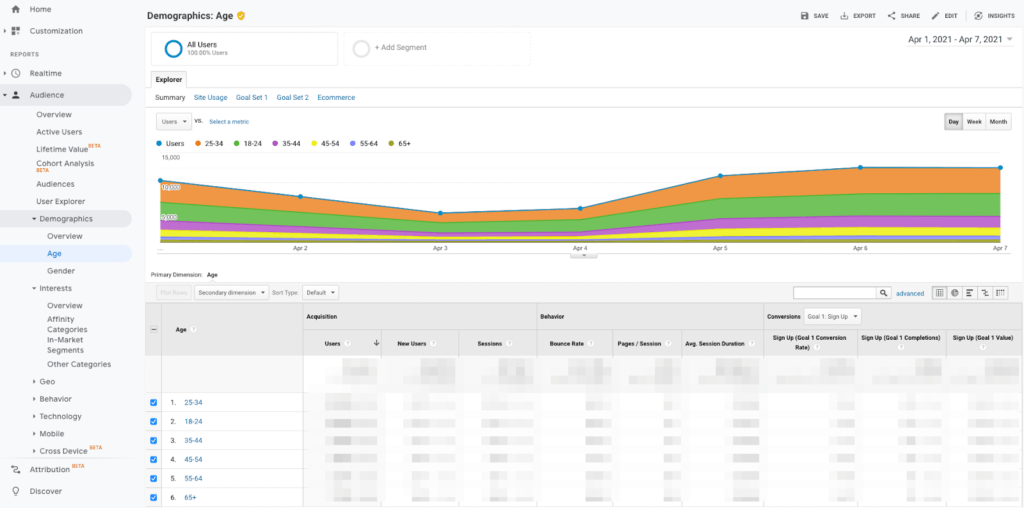
Under Demographics, you can learn:
- Your audience’s age
- Their gender breakdown
- Traffic and conversion data according to each above
The Interests tab can provide broad information about what types of information your visitors are interested in:

Talk to Your Customer Service Team and Internal Subject Matter Experts
Your customer support team knows your customers better than anyone. They talk to them every day and hear more honest evaluations about your products and services than perhaps anyone else in your company.
Sometimes marketing departments are shielded from the most blunt feedback their companies get from customers. But addressing those concerns headfirst can be an incredible opportunity to create content that earns trust with customers (and cuts down on complaints).
The first step is to identify internal subject matter experts (either within your company or your client’s organization). Then, set up a time to speak with them, and ask the following questions:
- Who are your target customers? Like, really, who are they?
- What do your customers do with your products or services? Go beyond the obvious. What are the real problems they’re facing that you help solve?
- Why do those problems exist? This is a more complex question than it might seem.
- How do customers use your products and services to solve those problems? Sometimes the way we think customers use our products and how they use them can be very different.
- When do customers typically buy from you? At what point do they determine you’re the best solution, and what motivates them to choose you over other options?
These are basic things marketers should know about their customers anyway, but they’ll inform which keywords you select and how you formulate angles to target topics that matter to them.

Read the Same Sites Your Audience Does
If you don’t have much in common with your customers, then one of the best ways to learn what matters most to their industry or community is to read the same websites they do.
This includes relevant industry publications and sites that are popular with similar audiences. You can learn a ton about which types of topics resonate best with the folks you’re trying to reach.
But how do you find those sites and understand which content is most successful in those niches? BuzzSumo can show you which content has been shared on social media the most based on a given keyword or topic. This can also give you an idea of which sites are most relevant to those topics.
Here’s an example of a search for “SEO content strategy”:
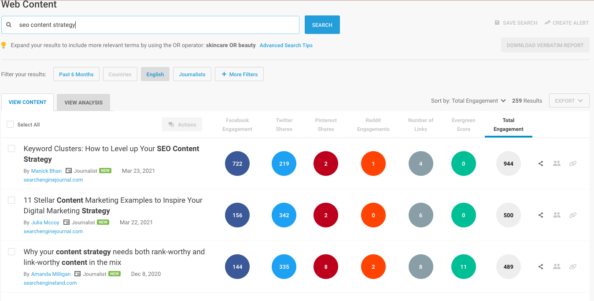
You can also use BuzzSumo to identify journalists and influencers within a given space too.
When you have a list of publications and influencers your audience read and follow, consider using an RSS reader like Feedly to track sources and Twitter and LinkedIn to follow influencers.
Hang Out Where Your Audience Does Too
Not every niche has much activity on social media specifically. But for every interest and industry, there’s an online community somewhere.
SparkToro, a somewhat new audience research tool from Moz co-founder Rand Fishkin, can help here. Enter a topic, and it’ll help you find where people interested in that term typically spend their time online (it’s a paid tool, but its free version has a reasonable amount of functionality):
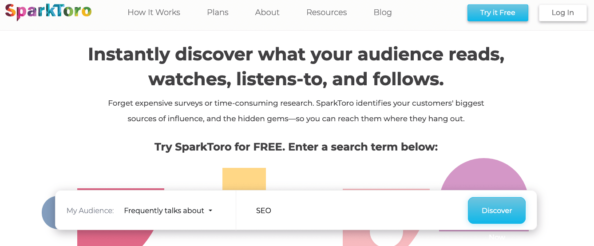
Use Surveys
Audience and customer surveys are an excellent way to understand your target customer base. If there’s anything you want to know, this is an easy way to ask.
There are several easy-to-use survey tools you can use:
Think back to the section of this post on audience personas. What would you ask to find the answers to those questions you have about your target customer base? Start there.
Connecting Keyword Research, Search Intent, and the Sales Funnel
Once you understand your audience, you can develop an understanding of how those folks use search engines when they’re looking for products and information.
Three Types of Search Intent
When people use a search engine, they typically have a goal in mind. Something they’re to get done. This is what we call search intent.
Most searches fall into one of three categories:
- Navigational: Searching a login page or a site they already know.
- Information: Searching to learn something or do research.
- Transactional: Searching for products or services.

MarketMuse shows the prevalent search intent for any topic and indicates whether that intent is fractured (ie. more than one intent appears in the SERP).
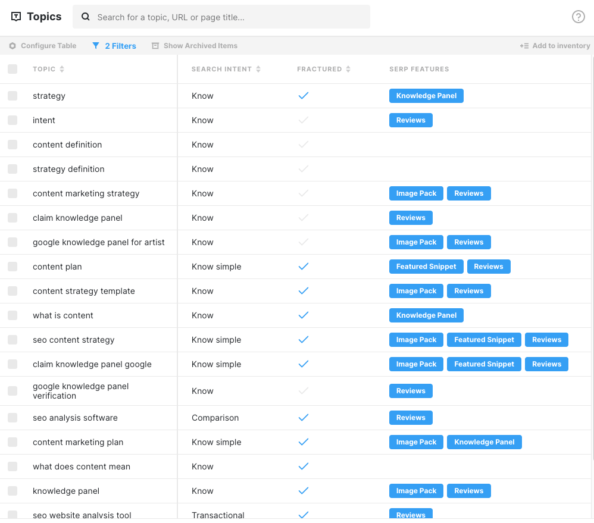

Conducting Smart Keyword Research
Stereotypical keyword research processes look something like this:
- Find which keywords people search for.
- Sort them by highest volume and lowest difficulty.
- Hire writers to work through a list of topics.
This process prioritizes what’s easy to execute over what’s most effective. Instead, let’s walk through a keyword research process that puts people first.
Here are some SEO platforms and keyword research tools to consider:
You’ll use these tools to research target keywords. These terms will fall into two categories:
- Your top keywords: These are the terms most closely associated with your product or service.
- Secondary keywords: These are terms related to tangential topics in your industry that customers might search for but might not be directly related to your products and services.
Here’s how you can build an enormous list of keywords relatively quickly.
Start by opening your keyword research tool of choice and entering the name of your industry or a product category (I’ll search for “guitars” using Ahrefs for demonstration purposes):
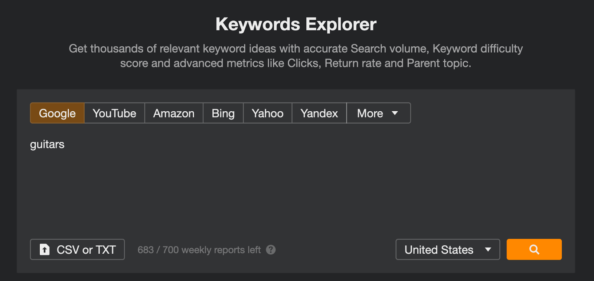
This will help us find tons of helpful information about our primary keyword. Typically, these types of keywords that target broad product categories can be very competitive:

While it would be great to rank for this topic, we will need to find other related topics that may be easier to rank. We can see those by looking at the associated keywords our SEO tool has surfaced:
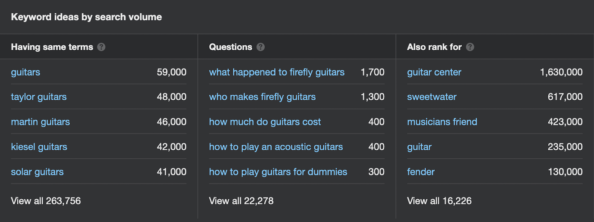
Most keyword research tools should help you find related terms like this. You should also be able to export them as a .csv. We can immediately see there are tens of thousands of associated terms for us to dive into here.
Export each of these lists from your SEO software or keyword research tool and drop them into a spreadsheet. Then, you can start grouping related keywords into topical buckets (you can do this easily with Ahrefs by looking at parent topics—here’s a look at a group of keywords around “types of guitars”):

You can use MarketMuse to surface topics with a close semantic relationship. For example, if you’re going to talk about different guitar types, you’ll want to build out pages around these ones.

Plus, you can bring your keyword research into MarketMuse to evaluate using sophisticated metrics such as Personalized Difficulty, Topic Authority, Competitive Advantage and Potential Value.
Next, you’ll need to prioritize which keywords are most important. The traditional method is to start with your highest-volume and lowest-difficulty keywords:

This is the easiest way to rack up high-ranking content that drives tons of traffic fast. But it might not be the best method for long-term success. Not by itself, at least.
Prioritizing Topics and Aligning Them With Your Sales Funnel
A better approach understands your sales funnel and prioritizes content that 1) addresses your customer’s top problems and 2) is most likely to turn readers into buyers.
Here’s a visual explanation of how a simple sales funnel works:
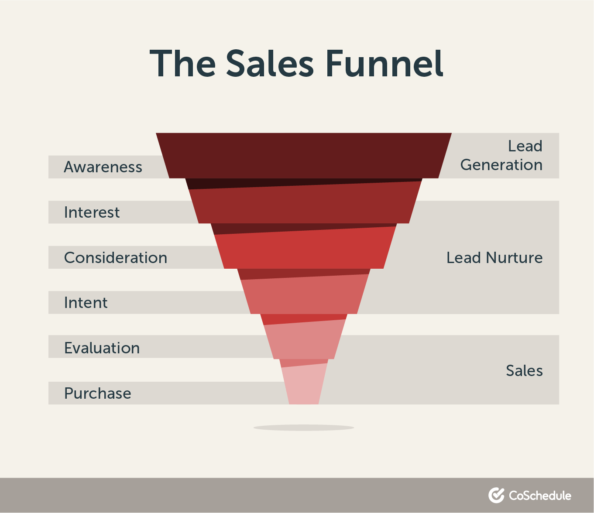
There are two caveats to address here:
- Most people do not move linearly through the funnel. This makes mapping marketing funnels somewhat difficult since user behavior can be challenging to predict.
- But every potential prospect will go through each stage at some point. So, it’s essential to have content that addresses each step.
Let’s group these keywords like this:
- Identify which terms are Navigational, Informational, and Transactional.
- Next, group keywords by topic. Keep your focus narrow.
- Then, match them up with funnel stages (TOFU, MOFU, and BOFU).
Here’s a look at how you might align content types and topics with your funnel:

Prioritize your keyword groupings by importance. Follow these steps:
- Start with keywords that are most closely related to your product. These are your money keywords that will drive sales.
- Then move onto the most common problems and use cases customers have for your products. These keywords help readers connect questions they have with the product solutions you offer.
- Next, group ideas that are relevant to your audience and are highly searched. These keywords help earn trust with the correct audience (and eventually, might earn their business).
This shortlist of the most important keywords can be further refined within MarketMuse to prioritize your highest-potential topics. MarketMuse Personalized Difficulty is a proprietary metric that measures how hard it is to rank for a topic, based on your site’s success at publishing content around that subject. It provides an indication of how much effort is required to be successful.
Competitive advantage is another proprietary metric that measures your topical authority and helps predict how likely you are to succeed at publishing content on that topic.
Potential value is a way to attribute a dollar value to the effort. Combined you come up with a plan that has a realistic chance of success and has a quantifiable value.

Whichever method you choose, you now have a solid foundation for which content you should create. The best part is it’s all backed by both audience research and search data.
Turn Keywords Into Actual Article Ideas
At this point, you have a ton of keywords. They’re organized by importance and relevance, and they’re grouped based on topics. Now, you’ll need to turn keywords into ideas you can create.
Analyze Your Keyword Set
Let’s say you have the following keywords:
- “fender guitars”
- “is fender better than gibson?”
- “rare fender guitars”
- “p-bass vs. j-bass”
All of these keywords are related to Fender. Yet each one is distinct. Let’s take a look at some potential headlines we could write based on each one:
- The Complete History of Fender Guitars (That No One’s Ever Told You)
- How to Choose Between Fender and Gibson Guitars and Make the Best Purchase
- Why Are Some Fender Guitars so Rare (And Where Can You Find Them)?
- Understanding the Subtle Differences Between Precision and Jazz Basses
Keep Your Article Ideas Organized
Now, you can start matching keyword data with real topics you can cover. Build a backlog of ideas you can pull from, prioritized by importance, and keep them organized.
You can do this with a few different tools:
- A simple spreadsheet
- MarketMuse
- CoSchedule’s Idea Board
Establish a Basic Publishing Cadence
There’s no such thing as a one-size-fits-all ideal publishing schedule.
But consistency does matter, so start small and scale up slowly. If you’re starting out creating content (or if you’re creating content without a defined cadence), here’s an example of a basic publishing schedule and how it can scale:

There are three things to consider with this proposed schedule:
- Quality beats quantity for SEO. If your content isn’t ranking right now, it might be because it isn’t up to par with your competitors. Take the time to get it right.
- Yet, it takes consistency to build an audience. You’ll need multiple pieces driving compound organic traffic over time to gain recognition and earn trust.
- Start small. This is a long-term play. Avoid burnout by setting a realistic pace.
Plan Content and Deadlines on Your Content Calendar
Editorial calendars are essential for content planning. They help teams in several different ways:
- They make it clear when content is due. Without deadlines, plans are just wishes.
- They make it easier to work strategically. When you plan content, you can avoid last-minute fire drills and create content purposefully and intentionally.
- They give teams visibility into what’s getting worked on. When stakeholders ask what you’re working on, calendars make it easy to show them.
Here’s an example of a content calendar:
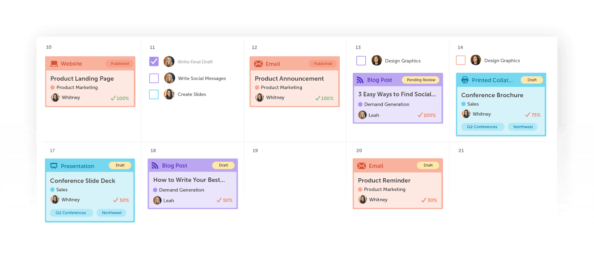
You can create a content calendar either with a spreadsheet or software like CoSchedule. If you start one yourself, make sure it includes:
- What you’re going to publish
- When you’re going to post it
- Who is responsible for working on it
This should be sufficient to get started organizing your content publishing.
Planning for SEO Success With Better Creative Briefs
Every piece you publish should start with a content brief. And each brief should address the SEO requirements your content will need to succeed long-term.
Topic + Keyword Data
SEOs and marketers sometimes think about keywords in isolation from one another. However, it’s best to think about them in context with one another. Every brief should answer:
- What is this piece actually about?
- Which terms do people use when they want to learn about this topic?
- What will the reader hope to accomplish after reading a piece of content on this topic?
Target Persona
If you have documented personas, either include a link to where they can be found or list the persona’s name within the brief. Just make it clear who precisely this content is for.

Angle
You can rank content without caring about your angle (for now, at least). But if you want people to care (and buy), you’ll need to give them a reason.
This starts with establishing a clear angle for your content. What perspective are you bringing to your topic? Get this right, and you won’t just drive more traffic, but more conversions too.
Here’s some insight into why a good angle is crucial for good content from Releventure:
“Interesting people are passionate, and angles are no different. By using the things that you are passionate about as a springboard to find associations between your article topic and how it relates to your wider audience, you will find unique ways to renew outdated information.”
This is one of the most potent pieces of any creative brief, second only to the next step in this section.
Outline
Most outlines include a list of potential subheadings. Some outlines plan to include target keywords in those subheadings.
However, the best outlines break down each section of each subheading with key details the content must cover.
This helps writers:
- Develop a clear understanding of what the content should be about.
- Ensures your keywords are targeted appropriately within the context of the topic.
- Eliminates rework when writers miss the mark (which typically stems from poor direction).
If you can combine a strong angle with a thoughtful outline and back it up with reliable keyword data, you’ve done much of the heavy lifting necessary to create content that will earn trust from search engines and actual human people with money to spend.
Here’s an example of what an effective outline could look like:

If this seems like a lot of work, consider automating some of this process with MarketMuse. Here’s part of a content brief generated by MarketMuse.
Humans and Robots, Living in Harmony
There’s more to know about SEO and content strategy than what will fit in one blog post. But you now know all of the basics required to bring the human and the algorithmic sides of driving and converting search engine traffic together.
Fortunately, with tools like MarketMuse and others now on the market, there’s never been a better time. Work that used to take weeks or months now might take hours or days.
So, what are you waiting for? It’s time to get to work.
About the Author
Ben Sailer is the Inbound Marketing Director at CoSchedule. His specialties include content strategy, SEO, copywriting, and more. When he’s not hard at work helping people do better marketing, he can be found cross-country skiing with his wife and their dog. You can reach out to him on LinkedIn and Twitter.
What you should do now
When you’re ready… here are 3 ways we can help you publish better content, faster:
- Book time with MarketMuse Schedule a live demo with one of our strategists to see how MarketMuse can help your team reach their content goals.
- If you’d like to learn how to create better content faster, visit our blog. It’s full of resources to help scale content.
- If you know another marketer who’d enjoy reading this page, share it with them via email, LinkedIn, Twitter, or Facebook.
